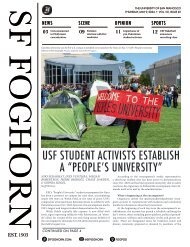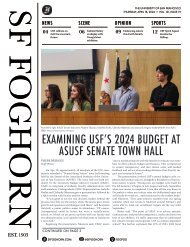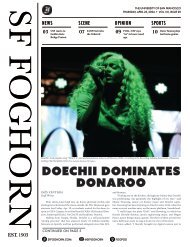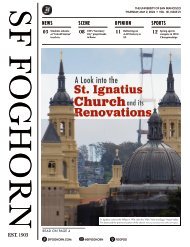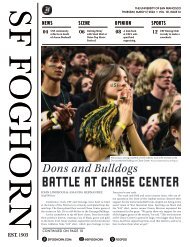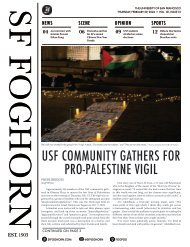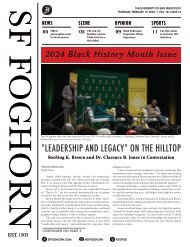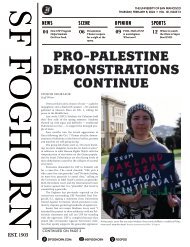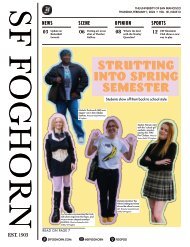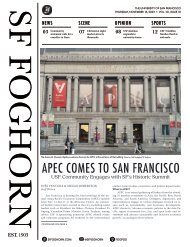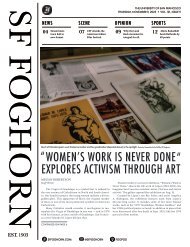Create successful ePaper yourself
Turn your PDF publications into a flip-book with our unique Google optimized e-Paper software.
SF FOGHORN<br />
EST. 1903<br />
NEWS<br />
03<br />
USF Debate hosts<br />
Senator Weiner at<br />
AI forum.<br />
PHEBE BRIDGES<br />
Staff Writer<br />
Throughout the past seven weeks, full-time faculty and<br />
librarians have had the option to sign an anonymous letter titled<br />
“A Petition of No Confidence: The Narcissism and Incompetence<br />
of President Paul J. Fitzgerald.” This letter arrived in<br />
full-time faculty and librarian mailboxes, and the Foghorn’s<br />
newsroom, on Feb. 22.<br />
The authors of the letter self-identify as “seven faculty<br />
members and librarians at the University of San Francisco who<br />
are gravely concerned about the future of this university.”<br />
The six-page letter presents 13 reasons why they are petitioning<br />
for a vote of no confidence against President Paul Fitzgerald,<br />
S.J. The letter states that “[a] review of President Fitzgerald’s<br />
performance over the past decade strongly suggests he<br />
ought to retire or step down from his position.”<br />
USF spokesperson, Kellie Samson, stated on Mar. 25 that<br />
Fitzgerald “supports the right of the members of the faculty<br />
and librarians to express their opinion, to raise questions and<br />
concerns about university operations, and to engage with the<br />
SFFOGHORN.COM<br />
SCENE<br />
07<br />
Style meets taste<br />
at KUSF’S annual<br />
Rock ‘N Swap.<br />
@SFFOGHORN<br />
OPINION<br />
08<br />
THE UNIVERSITY OF SAN FRANCISCO<br />
THURSDAY, APRIL 11, 2024 • VOL. 121, <strong>ISSUE</strong> <strong>18</strong><br />
university leadership on productive solutions to challenges.”<br />
The Foghorn reached out to Fitzgerald on Apr. 1 and Apr.<br />
4 for direct comments on each of the following accusations<br />
covered in this article. He did not respond to these emails,<br />
and on Apr. 5, Samson contacted the Foghorn confirming that<br />
Fitzgerald had received the requests for comment. She referred<br />
to her earlier statement, noting there was “nothing further to<br />
add at this point.”<br />
The authors of the petition worked independently from<br />
the USF Faculty Association (USFFA), but adhere to the<br />
union’s protocol. A petition like this is the first step in the process<br />
of removing a university administrator at USF. According<br />
to the Procedure for Vote of Confidence/No Confidence from<br />
the USFFA, for a vote to occur, 15% of USFFA members would<br />
need to sign the petition.<br />
The period to submit signatures ended on Apr. 1. “Petitions<br />
were counted on Tuesday [Apr. 2],” said Michael Webber,<br />
USFFA president and sociology professor. He confirmed<br />
that they received 43 out of the 65 petition signatures needed<br />
to reach 15%. Though this petition cannot move forward into<br />
vote, there is still a possibility that a full-time faculty member<br />
FOGPOD<br />
Embracing culture<br />
as a Lebanese<br />
American.<br />
SPORTS<br />
President Paul Fitzgerald, S.J. was elected to his role in Apr. 2014, and began his tenure in Aug. of that year. Photo courtesy of USF’s Flickr.<br />
CONTINUED ON PAGE 4<br />
11<br />
Goodbye to USF<br />
Tennis.<br />
INVESTIGATING ANONYMOUS PETITION OF NO<br />
CONFIDENCE AGAINST PRESIDENT FITZGERALD<br />
Petition Fails to Gather Signatures Needed to Pass
02 03<br />
THURSDAY<br />
APR. 11<br />
2024<br />
STAFF<br />
Editor in Chief<br />
MEGAN ROBERTSON<br />
mrrobertson2@dons.usfca.edu<br />
News Editor<br />
NIKI SEDAGHAT<br />
nisedaghat@dons.usfca.edu<br />
Opinion Editor<br />
CHISOM OKORAFOR<br />
cokorafor@dons.usfca.edu<br />
Scene Editor<br />
INÉS VENTURA<br />
ipventura@dons.usfca.edu<br />
Sports Editor<br />
CHASE DARDEN<br />
cbdarden@dons.usfca.edu<br />
Photography Editor<br />
SAMANTHA AVILA GRIFFIN<br />
svavilagriffin@dons.usfca.edu<br />
General Reporter<br />
PHEBE BRIDGES<br />
pjbridges@dons.usfca.edu<br />
General Reporter<br />
ELINA GRAHAM<br />
emgraham@dons.usfca.edu<br />
415.422.5444<br />
sffoghorn.com<br />
SUBMISSION POLICY<br />
The San Francisco Foghorn is the<br />
official student newspaper of the<br />
University of San Francisco and<br />
is sponsored by the Associated<br />
Students of the University of San<br />
Francisco (ASUSF).<br />
The thoughts and opinions<br />
expressed herein are those of the<br />
individual writers and do not<br />
necessarily reflect those of the<br />
Foghorn staff, the administration,<br />
the faculty, staff or the students of<br />
the University of San Francisco.<br />
Contents of each issue are the sole<br />
responsibilities of the editors.<br />
An All-American<br />
Publication<br />
ad maiorem dei<br />
gloriam<br />
The San Francisco Foghorn is free<br />
of charge.<br />
Advertising matter printed herein<br />
is solely for informational purposes.<br />
Such printing is not to be construed<br />
as written or implied sponsorship<br />
or endorsement of such commercial<br />
enterprises or ventures by the San<br />
Francisco Foghorn.<br />
©MMIV-MMV, San Francisco<br />
Foghorn. All rights reserved. No<br />
material printed herein may be reproduced<br />
without prior permission<br />
of the Editor in Chief.<br />
SAN FRANCISCO<br />
FOGHORN<br />
Freedom and Fairness<br />
Managing Editor<br />
JORDAN PREMMER<br />
jepremmer@dons.usfca.edu<br />
Copy Editor<br />
SOPHIA SIEGEL<br />
scsiegel@dons.usfca.edu<br />
Layout Editor<br />
ANYA JORDAN<br />
arjordan@dons.usfca.edu<br />
Layout Editor<br />
HALLEY COMPUTESTO<br />
hmcompuesto@dons.usfca.edu<br />
Social Media Manager<br />
MARIA ZAIED<br />
mfzaied@dons.usfca.edu<br />
Online Editor<br />
ESHA DUPUGUNTLA<br />
ekdupuguntla@dons.usfca.edu<br />
ADVISOR<br />
TERESA MOORE<br />
2130 FULTON STREET, UC #417<br />
SAN FRANCISCO, CA 94117<br />
Columns for the Opinion section<br />
and Letters to the Editor are gladly<br />
accepted from students, faculty, staff<br />
and alumni.<br />
All materials must be signed and<br />
include your printed name, university<br />
status (class standing or title),<br />
address, and telephone number for<br />
verification. Anonymous submissions<br />
are not published.<br />
We reserve the right to edit materials<br />
submitted. All submissions<br />
become the property of the San<br />
Francisco Foghorn.<br />
Staff editorials are written by the<br />
Foghorn editorial staff and represent<br />
a group consensus.<br />
The San Francisco Foghorn Opinion<br />
page is a forum for the free, fair and<br />
civil exchange of ideas. Contributors’<br />
opinions are not meant to<br />
reflect the views of the Foghorn staff<br />
or the University of San Francisco.<br />
Students interested in contributing<br />
to the Foghorn can scan and fill out<br />
the QR code below.<br />
STAFF EDITORIAL<br />
Arab American heritage Month<br />
BLACK, WHITE, AND WORN ALL OVER;<br />
THE SIGNIFICANCE OF THE KEFFIYEH<br />
This week marks six months<br />
of mass violence against Palestinians<br />
in Gaza by Israel. Six months<br />
of bombing, man-made famine, and<br />
siege. However, it has also been six<br />
months of global mass mobilization<br />
and protest for the Palestinian cause.<br />
The Foghorn has reported on such<br />
demonstrations on USF’s campus.<br />
Among the crowds of protestors, it’s<br />
not uncommon to spot the black-andwhite<br />
patterned keffiyehs: headdresses<br />
that have become representative of<br />
standing with the Palestinian people.<br />
During Arab American Heritage<br />
Month, the Foghorn wants to spread<br />
awareness about the keffiyeh, worn<br />
around our campus. The keffiyeh<br />
has become an international symbol<br />
of Palestinian resistance, and a good<br />
way to express solidarity even thousands<br />
of miles away. Supporters need<br />
to be aware of its significance when<br />
they wear it.<br />
As described by Handmade<br />
Palestine, a keffiyeh factory in Ramallah,<br />
Occupied Palestine, a close<br />
inspection of a keffiyeh will reveal<br />
three design elements. Over time,<br />
they’ve been linked with elements of<br />
Palestinian life. The first portion is<br />
a fishnet pattern, a reference to the<br />
long history of Palestinian fishermen<br />
and freedom found on the sea. The<br />
second element is a pattern of waves:<br />
sometimes described as waves of the<br />
sea, other times described as olive<br />
leaves, as olive trees have long been<br />
a symbol of significance to Palestinians.<br />
The two patterns are separated<br />
by bold lines, which represent the<br />
trade routes across historic Palestine.<br />
The keffiyeh wasn’t always a symbol<br />
of resistance. The headdress was<br />
Photo Illustration by Jordan Premmer/SF Foghorn.<br />
first worn by nomadic Bedouin men,<br />
in historic Palestine, functioning as<br />
both protective wear against the environment<br />
and a symbol of identity.<br />
In the 1930s, the keffiyeh found another<br />
practical use — as a way for<br />
fighters to conceal their identities<br />
during the Arab Revolt against British<br />
colonizers. Palestinian civilians<br />
then began to wear it in widespread<br />
fashion to show solidarity with the<br />
militants.<br />
In the ‘60s, the keffiyeh became<br />
closely associated with Palestine Liberation<br />
Organization leader Yasser<br />
Arafat, who popularized it internationally<br />
as an emblem of resistance<br />
to Israeli occupation. According to<br />
Hirbawi Kufiya, when Israel banned<br />
the Palestinian flag for 26 years, the<br />
white-and-black keffiyeh became a<br />
substitute symbol of Palestinian nationalism.<br />
In recent months, both demand<br />
and repression of the keffiyeh have<br />
increased. The remaining keffiyeh<br />
factories in Occupied Palestine have<br />
a backlog of thousands of orders. At<br />
the same time, there have been multiple<br />
instances of people wearing keffiyehs<br />
being targeted for violence.<br />
Internationally, the keffiyeh is<br />
being promoted as a symbol for people<br />
to show solidarity with Palestinians<br />
under siege. The California<br />
Council on American-Islamic Relations<br />
recommended wearing the keffiyeh<br />
to raise awareness for Gaza.<br />
Crucially, the symbolism of the<br />
keffiyeh can only be fully understood<br />
once one knows about its cultural<br />
and historic significance. When worn<br />
with care and respect, the keffiyeh is<br />
a beautiful symbol of solidarity.<br />
SOPHIA MCCRACKIN<br />
Staff Writer<br />
DEBATE TEAM TAKES ON SENATOR<br />
WEINER’S AI LEGISLATION<br />
On Friday, Apr. 5, the USF Debate Team hosted California State<br />
Senator Scott Weiner in a forum to discuss SB 1047, a new bill in the<br />
state legislature to regulate artificial intelligence (AI) models. Five<br />
members of the debate team delivered speeches explaining and critiquing<br />
the bill before Weiner answered audience questions. Weiner<br />
introduced the bill on Feb. 7, and it passed the California Senate Judiciary<br />
Committee on Apr. 2.<br />
“Whenever we talk about anything policy related in debate,<br />
it always follows with what regulation should be put into place for<br />
that particular policy,” said first-year English major and debate team<br />
member, Mariah Moore. “Scott Wiener’s newly introduced legislation<br />
on developing safe large scale AI caught the attention of the team with<br />
the bill being the first of its kind.”<br />
Senior philosophy major Kendrick Lacerda presented “three existential<br />
risks” that artificial intelligence poses to society: the degradation<br />
of democracy, supercharged totalitarianism and engineered<br />
pandemics.<br />
Lacerda explained that AI models can determine a user’s political<br />
preferences by analyzing the language used to ask the model political<br />
questions, and then cater to that preference. Lacerda argued that AI<br />
can drive a wedge into politics and benefit authoritarian regimes by<br />
manufacturing propaganda. He further argued, AI is capable of synthesizing<br />
new information, information that humans have not fed it.<br />
This means that there is a concern about an AI with an understanding<br />
of biochemistry manufacturing a contagion the likes of which humans<br />
have not yet invented.<br />
Beyond existentialism, many argued that AI poses immediate<br />
inconveniences to society. “I’m having to consistently explain to my<br />
grandmother that Donald Trump is not trying to sell her hair products,”<br />
Moore told the forum.<br />
Elise Green, a first-year economics major on the debate team,<br />
condensed the bill into a few points, including the safety framework<br />
of the bill and the creation of a public cloud. This public cloud enables<br />
comprehensive AI regulation of each developer who uploads<br />
an AI model.<br />
“Most bills that are actively being passed or have been passed<br />
are about dealing with the issues that have already come up and [SB<br />
1047] is to get ahead of new technology, and it would be the first in<br />
the U.S. to do this,” Green said.<br />
Chisom Okorafor, a sophomore politics major and the Foghorn’s<br />
opinion editor, offered Weiner feedback on the legislation<br />
from the debate team. The team’s reaction to the bill was mostly<br />
favorable, but, on the whole, they called for the bill to be more comprehensive.<br />
Camila Ayala Hurtado, a sophomore politics and psychology<br />
major on the debate team, proposed several amendments to the<br />
bill. “I partially support it. I think it has great potential, but cannot<br />
regulate anything due to the extremely high threshold. This<br />
bill needs to regulate current AI systems that are causing problems<br />
right now,” she said.<br />
This hesitation stems from the size of the AI models covered<br />
in this legislation. The bill regulates AI models “Trained using a<br />
quantity of computing power greater than 10^26 integer or floating-point<br />
operations in 2024, or a model that could reasonably be<br />
expected to have similar performance.” Popular AI models, like<br />
ChatGPT, are too small to be affected by the passage of the bill.<br />
Another concern for the debate team was the environmental<br />
impact of retraining large AI models. Okorafor said, “According to<br />
Facebook’s head of AI, training a large model once can cost ‘millions<br />
of dollars’ in electricity consumption. Training a language model like<br />
ChatGPT-3, for example, is estimated to use just under 1,300 megawatt<br />
hours of electricity; researchers estimate just one training of the<br />
model is the equivalent of powering the average American’s home for<br />
120 years.”<br />
Attendee Julia Olsen, a sophomore sociology major, said, “I really<br />
like how many facts the debaters brought to the table.” Piper Sparano,<br />
a sophomore psychology major said, “The more I understand why it’s<br />
scary, the less scared I am.”<br />
Weiner said, “I think what keeps me up at night is what we know<br />
AI is doing right now,” he said, echoing the debate team’s concerns.<br />
Weiner explained that his main concern was the polarizing effect of<br />
artificial intelligence models and their potential political impact.<br />
Weiner is running for re-election to the state senate in 2024, and<br />
CalMatters predicts that Weiner has a high likelihood of rewinning<br />
the seat. “We don’t want innovation for the sake of innovation,” he<br />
noted.<br />
When asked about the enforcement scheme of the bill, the Senator<br />
produced a response about private citizens being unable to sue<br />
AI companies under this legislation, leaving the responsibility of enforcement<br />
up to the California State Attorney General.<br />
Robert Boller, a USF Rhetoric Professor and the coach of the debate<br />
team, said, “The more students are involved with experiential<br />
education, internships, and anything that makes what you are talking<br />
about in classes more real, the better.”<br />
Editor’s Note: Interviewee and USF Debate Team member Chisom<br />
Okorafor is the Foghorn’s opinion editor and Elise Green is one of the<br />
Foghorn’s deputy writers.<br />
Editor-in-Chief: Megan Robertson, Chief Copy Editor: Sophia Siegel,<br />
Managing Editor: Jordan Premmer, News Editor: Niki Sedaghat<br />
Foghorn Opinion Editor Chisom Okorafor, pictured above, shared the debate team’s<br />
feedback on the legislation with Senator Weiner, who represents District 11, which<br />
includes all of San Francisco. Photo by Kaleb Martinez/SF Foghorn.<br />
NEWS
04 05<br />
THURSDAY<br />
APR. 11<br />
2024<br />
NEWS<br />
CONTINUED FROM FRONT PAGE<br />
CONTENTS OF THE LETTER<br />
could draw up another petition of no confidence, which could then<br />
result in a vote if it reached the 15% threshold.<br />
On Apr. 8, Webber provided the Foghorn with a statement from<br />
the minutes of USFFA’s Apr. 4 Policy Board meeting: “A motion was<br />
made to form a subcommittee… to seek feedback from members on<br />
the University President and the issues raised in the petition with the<br />
task of… determining appropriate next steps based on this feedback.<br />
Anyone who wants to be on the committee can write to the USFFA<br />
Secretary by the end of next week.”<br />
This is the second time in recent years that the USFFA has enacted<br />
a petition of no confidence regarding a member of the university’s<br />
administration. In 2019, history professor Mike Stanfield was one of<br />
the organizers behind a petition of no confidence against then Provost<br />
Donald Heller. Those petition organizers were on the record and the<br />
union held a vote which resulted in Heller stepping back from the Provost<br />
position. “I said publicly that we need to go after Heller, because<br />
if we don’t, the future of the faculty and of the university will be damaged.<br />
I put a public face on it, and I wasn’t afraid to do so,” Stanfield<br />
said.<br />
Unlike the 2019 petition of no confidence, this petition against<br />
Fitzgerald was sent anonymously. The Foghorn was unable to confirm<br />
the authors’ identities. There is no confirmation that any petition<br />
writers were members of the USFFA. To proceed with a vote, the union<br />
would need to confirm the petition was drafted by a full-time faculty<br />
member.<br />
“It would [have been] really useful if some of [the anonymous authors]<br />
went privately to union leadership and said, ‘We drafted this<br />
petition, you can be assured that we are members of the USF Faculty<br />
Association,” said Stanfield. “Some people were worried that, if we<br />
don’t have that assurance, how can we get behind this petition?”<br />
Many allegations in the letter use anonymous sources to comment<br />
on personal and professional accounts of negative experiences<br />
with Fitzgerald. As these cannot be verified by the Foghorn, focus will<br />
be given to claims with a public record. This article examines four<br />
claims: “Minimal enrollment management skills,” “A poor record of<br />
strategic investments,” “Deteriorating facilities,” and low faculty and<br />
The authors stated that there has been “poor prioritization” when dealing with facilities around<br />
campus, which the university denies. Harney Science Center, pictured above, is mentioned by<br />
name in the letter. Photo courtesy of USF’s website.<br />
staff morale.<br />
In response to concerns highlighted in the letter, Samson wrote,<br />
“The Board of Trustees and senior university leadership take concerns<br />
like those expressed in the letter very seriously. The factual and operational<br />
matters outlined in the anonymous letter were all known to<br />
the university leadership, including members of the Board of Trustees,<br />
before the letter was circulated. These operational matters were also<br />
presented to and discussed with the university community in many<br />
formats (town halls, emails, meetings, etc.) in our ongoing efforts to<br />
communicate in a timely and transparent way. Matters of opinion are<br />
those of the anonymous writer or writers.”<br />
Michael Hammond, President of USF’s Part-Time Faculty Association<br />
and an adjunct rhetoric professor, stated “regardless of where<br />
the petition leads, it is my hope that the questions raised inspire a<br />
renewed conversation on the need for transparent and participatory<br />
governance that includes all faculty, staff, and students.”<br />
The Foghorn contacted Provost Eileen Chia-Ching Fung on Apr.<br />
1 regarding the petition, but she declined to comment.<br />
“Minimal enrollment management skills.”<br />
To reify declining enrollment claims, the authors compare the<br />
percentages of 2017 and 2021 enrollment at 11 universities they believe<br />
“operate in a similar space as the University of San Francisco.”<br />
Within these cited universities, Golden Gate University has had<br />
the largest decrease in students, at -6.5%, and Chapman University<br />
has reported the largest increase, at 6.4%. In contrast, USF has suffered<br />
an enrollment decline of 9.4% from 2017 to 2021. Between 2017<br />
and 2023, USF suffered an enrollment decline of 16.9%. In 2017, USF’s<br />
population consisted of 11,080 students. In 2023, there were 9,212 students.<br />
USF’s Strategic Plan for Academic Years 2022 - 2027 lists the enrollment<br />
goal as 11,000. Reaching this number requires an increase of<br />
19.4% by 2027. Since 2017, however, enrollment at USF has decreased<br />
by approximately 3% annually.<br />
In an effort to resolve the decline in enrollment, the Strategic Enrollment<br />
Division alongside the academic deans constructed strategies<br />
involving “expanding digital marketing, providing additional<br />
scholarships, and enhancing yield efforts for admitted<br />
students,” according to Samson in a written statement. “Longer<br />
term, academic units are working to reinvigorate degree<br />
programs and certificates in areas that prepare students for<br />
professional success, including in healthcare and wellbeing;<br />
climate, energy and sustainability; and AI and technology.”<br />
The Foghorn reached out to Fitzgerald regarding university<br />
enrollment rates on Apr. 1, but he declined to comment.<br />
“A poor record of strategic investments.”<br />
The authors of the petition complained about the budgeting<br />
and investment of the university’s finances. “Faculty<br />
have been told, time and time again, that the university’s<br />
balance sheet is severely constrained,” the authors alleged,<br />
questioning such expenditures as the blood bank purchased<br />
in 2022, Star Route Farms acquired in 2017, and the Innovation<br />
Hive in the Harney Science Center that opened in 2022.<br />
The letter also criticizes USF’s attempted acquisition of the<br />
San Francisco Art Institute (SFAI) in 2022. Ultimately, the<br />
university backed out of that deal.<br />
The petition alleges that USF lent “6 million [dollars] to<br />
the San Francisco Art Institute, which then promptly went<br />
bankrupt and defaulted on USF’s generous loan.”<br />
On Apr. 1 and Apr. 4, the Foghorn reached out to Fitz-<br />
gerald regarding the investment record of the university, and he<br />
did not respond. On Fitzgerald’s behalf, Samson referred us to her<br />
earlier statement that prior to backing out of the deal “USF had<br />
loaned funds to SFAI for its operation,” and that “the loan is secured.”<br />
While the Foghorn can find no external confirmation that<br />
SFAI defaulted on the loan, the secured status of the loan means<br />
it is backed up by some form of collateral. This means USF would<br />
receive assets from SFAI should they not pay back the loan.<br />
Charlie Cross, USF’s vice president of Business and Finance,<br />
declined to comment regarding the loan.<br />
In regards to progress on renovations on the former blood<br />
bank, within her written response, Samson stated, “architects are<br />
working with USF to finalize design details” for turning the former<br />
blood bank into “what is envisioned as a Life and Health Sciences<br />
Campus.”<br />
Samson stated “The Office of Development is working to secure<br />
philanthropy to fund” renovations to the former blood bank.<br />
This clarification means that the money used to renovate the<br />
building will not come from tuition funds, but rather from donations.<br />
Michael London, the associate vice president of facilities management,<br />
stated that the new Life and Health Sciences Campus is<br />
anticipating “opening fall 2027.”<br />
The writers criticized expenditures like the purchase of the blood bank, which is slated to<br />
open as the Life and Health Sciences Campus in Fall 2027. Photo by Beau Tattersall/SF Foghorn.<br />
“Deteriorating facilities.”<br />
The authors allege “student complaints about black mold in residence<br />
halls and faculty complaints about leaky ceilings and pipes in<br />
Harney [Science Center] are commonplace.” They argue that because<br />
of “poor prioritization,” the university lacks money to address these<br />
problems.<br />
On Apr. 1 and Apr. 4, the Foghorn reached out to Fitzgerald regarding<br />
the alleged issues with facilities. He did not respond. On Fitzgerald’s<br />
behalf, Samson referred us to her earlier statement.<br />
“During the last 10 years, USF has spent in excess of $95 million<br />
on major maintenance projects and another $110 million in the decade<br />
prior,” Samson stated. “Additionally, in the last 10 years, USF has<br />
spent more than $200 million on new construction. USF has prioritized<br />
maintenance projects, which are funded through philanthropy,<br />
debt and operating budgets. The University has identified approximately<br />
$80 million in upcoming maintenance projects, as well as approximately<br />
$10 million in digital infrastructure work that will be<br />
undertaken in the next five to seven years.”<br />
The Foghorn reached out to Cross regarding the backlog of maintenance.<br />
He declined to comment.<br />
In London’s written response, “Facilities has a recurring, but<br />
limited, annual budget to cover maintenance. Larger maintenance<br />
needs… are covered out of other university funds which [are] handled<br />
when those funds are available.”<br />
Regarding the specific critiques of Harney Science Center and<br />
residence halls, London confirmed, “from time to time Facilities receives<br />
work orders to investigate perceived mold issues. Most of these<br />
requests are localized and related to specific incidents like a plumbing<br />
leak, windows being left open, or other window issues. Occasionally<br />
we receive reports of mold or mildew that are related to poor housekeeping<br />
habits of the occupants.”<br />
London continued, confirming “there have not been any lab results<br />
indicating toxic mold conditions. Facilities partners with Housing<br />
to help educate students, and staff, on ways to eliminate or reduce<br />
mold or mildew in their spaces.”<br />
Fromm Hall, a dorm that has previously had mold issues, underwent<br />
a roof replacement that began on Aug. 22, 2022 according to<br />
Facilities’ Construction Updates page. According to London, Fromm<br />
will have its windows replaced this summer to “improve the weather<br />
tightness of the window system.” This replacement is intended to aid<br />
Facilities’ “efforts to reduce the risk of mold due to exterior moisture<br />
intrusion,” he said.<br />
Regarding Harney Science Center, London said, “last summer,<br />
USF replaced the roof of Harney at a cost in excess of $1,000,000.<br />
Though the roof replacement resolved most of the water intrusion issues,<br />
several additional locations with leaks unrelated to the roof were<br />
identified over this extremely wet winter.”<br />
These additional water intrusions are slated to be addressed this<br />
upcoming summer. London continued, describing having “experienced<br />
at least two significant and unforeseen pipe failures which have<br />
been resolved.”<br />
According to USF’s Construction Updates page, the most recent<br />
construction on Harney took place on Jan. 19, where contractors repaired<br />
a leak that was reported on Dec. 1, 2023.<br />
“Morale that continues to decline, with no end in<br />
sight.”<br />
A decline in faculty and staff morale was another point cited.<br />
While the letter used anonymous sources from representatives within<br />
the University Budget Advisory Committee, Staff Advisory Council,<br />
the President’s Leadership Team, as well as term faculty and program<br />
assistants, we will not be publishing these claims as they could not be<br />
properly vetted by the Foghorn.<br />
However, the topic was brought up during interviews with faculty<br />
and staff members. Stanfield said, “…our sense of being an academic<br />
community has severely eroded since Father Privett left in 2015. Many<br />
of these people are my friends, and I respect them. It hurts me when<br />
they get hurt, so I feel like I have to speak up and embrace faith, not<br />
succumb to fear.”<br />
Hwaji Shin, an associate sociology professor, said, “We’ve been<br />
asked to do less with less, but students deserve more. It’s demoralizing<br />
for us to work less… when the demand for the students is far more<br />
than years ago…yes, we have fewer students, but that doesn’t mean the<br />
amount of work and care that each student deserves today is less than<br />
it used to be.”<br />
According to the USFFA’s “2023 State of the Faculty and Librarians<br />
Survey,” disclosed to the Foghorn by an anonymous union<br />
member, 44% of those surveyed reported their workload to be unsustainable.<br />
Additionally, 25% said they disagree with the statement that<br />
“they feel supported by the USF administration.” 33% of full-time faculty<br />
and librarians responded to the 2023 survey, which “was lower<br />
than in previous years, approximately 50% in 2022 and 2011.”<br />
On Apr. 1 and Apr. 4, the Foghorn reached out to Fitzgerald regarding<br />
concerns with low faculty morale. Fitzgerald did not respond<br />
and Samson declined to comment.<br />
The Foghorn will continue to report on breaking updates to the<br />
petition of no-confidence.<br />
Editor-in-Chief: Megan Robertson, Chief Copy Editor: Sophia Siegel,<br />
Managing Editor: Jordan Premmer, News Editor: Niki Sedaghat<br />
NEWS
06 07<br />
THURSDAY<br />
APR. 11<br />
2024<br />
ROCKIN’ RAGS<br />
The styles and sounds of KUSF’s Rock ‘n’ Swap<br />
TOTAL SOLAR ECLIPSE<br />
GRACES THE SKY<br />
INÉS VENTURA, ANYA JORDAN, & CHASE DARDEN<br />
Staff Writers<br />
Out of all the weeks to say “I hate Mondays,” this is not the one!<br />
On Monday, Apr. 8, a total solar eclipse graced North America’s sky,<br />
the first since 2017. People across the continent took to the streets<br />
with protective glasses in hand to catch a glimpse of the shining phenomenon.<br />
The National Aeronautics and Space Administration (NASA)<br />
stated, “A total solar eclipse happens when the Moon passes between<br />
the Sun and Earth, completely blocking the face of the Sun. The sky<br />
will darken as if it were dawn or dusk.”<br />
Andrew Franknoi, a professor of astronomy at the Fromm Institute<br />
here at USF, said to ABC7 last week, “We call eclipses the Super<br />
Bowl of sky spectacles. And I think it justly deserves that name, at<br />
least a total eclipse does.”<br />
Alyssa Flores, sophomore fine arts major<br />
Graphic by Anya Jordan/SF Foghorn<br />
The last total solar eclipse happened in 2017, with the path of totality<br />
spanning across North America from Oregon to South Carolina,<br />
making it the “first eclipse in 99 years visible across the country,” according<br />
to CBS News.<br />
This year, 15 U.S. states got a full view of the eclipse, as they fell<br />
within the 100-mile wide “path of totality” spanning from Mexico’s<br />
Pacific coast, across Texas to Maine, and into Canada as well.<br />
The view from Lone Mountain was not as spectacular as many<br />
had hoped. Here in San Francisco, we got a “partial view,” since the<br />
moon only covered 45% of the sun’s surface, according to NASA. The<br />
eclipse started at 10:14 a.m. and peaked at 11:13 a.m., when the crescent-<br />
shaped sun was most visible.<br />
The Foghorn asked a few students their thoughts about the eclipse<br />
Editor-in-Chief: Megan Robertson, Chief Copy Editor: Sophia Siegel,<br />
Managing Editor: Jordan Premmer, Scene Editor: Inés Ventura<br />
“I read somewhere that this eclipse is supposed to trigger a positive transformation, so I’m hoping that means I’ll pass my finals this<br />
semester.”<br />
Luminate, an entertainment data company, found that record vinyl sales in the U.S. increased by 21.7% for the first half of 2023. Photo by Samantha Avila Griffin/SF Foghorn<br />
REMI BRANDLI<br />
Staff Writer<br />
Channeling Haight-Ashbury in the ‘70s and the grunge movement<br />
of the ‘90s, Rock ‘N Swap is a runway for vendors and students alike.<br />
KUSF’s annual event took place this Sunday, Apr. 7 in the McLaren<br />
Complex, and reigns as “Northern California’s largest record fair,” according<br />
to KUSF, USF’s radio station.<br />
Within the first hour of the event, I counted a tally of at least 10<br />
flannels, five Carhartt or bomber jackets, two floral button ups and<br />
about five beanies, one being worn including by the head and heart of<br />
KUSF herself, General Manager Miranda Morris.<br />
“This swap feels closer to pre-pandemic,” said Morris, reflecting<br />
on the past two and a half years when the swap was trying to regain<br />
its footing as a major event for the station. “We’re selling out of vendor<br />
tables pretty consistently,” she said.<br />
Next to the rock-pop stand lived a $5 clothing rack, run by vendor<br />
Greg Martinez, with a wide variety from Bob Marley to Biggie, Nirvana<br />
to Led Zeppelin, Prince to The Beatles, even including a Lizzo<br />
shirt. I was able to snag a Nirvana and AC/DC T-shirt — please do not<br />
ask me to name five songs.<br />
Vinyls at the event ranged from ‘90s alternative rock to the classics<br />
of the ‘80s, and all the way back to pre-‘30s jazz. Many tables had<br />
a stockpile of Black music, including some of the founders of the rock<br />
genre, Ray Charles and Prince. Alongside these were the vinyl recordings<br />
of soul music legends like Bessie Smith, The Temptations and The<br />
Supremes.<br />
Across the way sat two USF professors, not to teach but to sell.<br />
Spanish professor David Mendez-Alvarez sold classical vinyls and<br />
CD’s. Next to Mendez-Alvarez was Giacomo Fiore, a professor in the<br />
music department, selling not records he had collected, but rather vinyl<br />
records he had recorded himself and released in 2014 and 2022. “I<br />
think I’m one of the only ones that does this,” said Fiore.<br />
Stationed towards the entrance was Thomas Navarro, a collector<br />
of Latin-American music. Dressed in Columbian leather and jeans, he<br />
looked like a true rockin’ biker from the “Grease” era. Navarro’s collection<br />
dates all the way back to the band Los Dug Dug’s self-titled<br />
release in 1971, to Shakira’s most recent release “Las Mujeres Ya No<br />
Lloran,” once again showing the variety of styles in the music collector<br />
scene.<br />
The Rock ‘N Swap has “always been a fundraiser… The money<br />
that we generate from this goes to support the program,” Morris<br />
said. And the Swap is not just for the DJ’s, collectors and sellers, it is<br />
purposefully accessible for college students to engage with the music<br />
scene for under $25. When you’re in college and start discovering new<br />
music, especially in SF – it’s a good crossroads whether you’re a new DJ<br />
or an experienced mixer or producer in the music scene.”<br />
Editor-in-Chief: Megan Robertson, Chief Copy Editor: Sophia Siegel,<br />
Managing Editor: Jordan Premmer, Scene Editor: Inés Ventura<br />
SCENE<br />
Julianna Sangalang, sophomore design major<br />
“I didn’t take out time of my day to see a partial eclipse…. I can see it on TikTok instead. I used to look at the sun all the time as a kid and I<br />
think that’s why I have such bad eyesight now.”<br />
Gabriela Marcucci, sophomore museum studies major<br />
“I heard you have to wear red during an eclipse to call in good health, so I called my dad back home and told him to put something red<br />
on our dog.”<br />
USF students get free entry to the Rock ‘N Swap while visitors pay $3. (Left to right,<br />
Yan Chen, Georgia Engle) Photo illustration by Samantha Avila Griffin/SF Foghorn<br />
Clare Henry, Kasey Chesnutt, and Lillian Thomas (shown above) coordinated with<br />
classic Coogi-esque sweaters. Photo illustration by Samantha Avila Griffin/SF Foghorn<br />
SCENE
08 09<br />
THURSDAY<br />
APR. 11<br />
2024<br />
Arab American<br />
heritage Month<br />
MY LEBANESE CULTURE: WHERE I ALWAYS FIND A HOME<br />
OPINION<br />
MICHELLE DAHER YAACOUB<br />
is a sophomore media studies<br />
major.<br />
It’s not just about hummus. It’s<br />
not all chicken shawarma wraps,<br />
grilled to perfection, with a side of<br />
hummus and fresh, soft pita bread.<br />
It’s not only about a finjein of Turkish<br />
coffee to start every morning, or<br />
about the nature of our shareable<br />
meals. Lebanese cuisine is one of<br />
life’s greatest pleasures to me, so I<br />
understand why everyone loves it.<br />
Food is a massive part of our culture.<br />
However, there’s so much more<br />
than cuisine to love about Lebanese<br />
and Middle Eastern culture that I<br />
wish was more understood in the<br />
United States. Connecting with my<br />
culture means connecting to my<br />
home, family and land. Finding that<br />
connection in the U.S. tends to be<br />
difficult for me because of the ways we are minimally represented, so<br />
I cherish every bit of culture I find.<br />
If I’m going to tell you some cultural story involving food, I don’t<br />
want to only tell you our recipes and food traditions. I also want to<br />
tell you how, as a little girl, my dad’s mom would show my cousins<br />
and I how to spin bread dough and use the saj for fresh saj bread. The<br />
smell would fill the basement of our home in the southern Lebanon<br />
mountains. I want you to hear about the way my mom’s mother always<br />
asks me what I want to eat, and will forcefully serve me a five-course<br />
meal even if I say I’m not hungry.<br />
I want to tell you how Lebanese culture to me is the generosity<br />
of our people. It’s the feeling of being back in that land – whether in<br />
the bustling capital city of Beirut or up in the tight roads of the small<br />
mountain villages. It’s the feeling of the warm, welcoming love from<br />
jido and teta who cook their best recipes just for me when I’m home<br />
for the summer. I want you to know how strong our connection is<br />
to extended family, and the way we find family wherever we are in<br />
Lebanon, blood-related or not. I can tell you how little of that homey,<br />
comforting warmth I feel in the U.S.<br />
Photo courtesy of Michelle Daher Yaacoub<br />
Aside from the obvious cultural differences between the U.S. and<br />
Lebanon, there’s so much I wish I could share about Lebanese and<br />
Middle Eastern culture. Many people don’t realize how little correct<br />
language there is to describe us. We’re “Arab,” but many Lebanese<br />
people such as my dad assert that we’re Phoenician instead. I’m “Middle<br />
Eastern,” but that term comes from the Western perspective. Until<br />
this year, the U.S. census considered us to be white but that doesn’t<br />
explain why many of us don’t look white and aren’t treated as white.<br />
Regardless, I am 100% Lebanese, even without the proper American<br />
categories to describe me.<br />
The Lebanese experience in America is the way my head snaps<br />
around any time I hear Arabic speech or music anywhere. I’m grasping<br />
for crumbs of anything from my culture, and that tiny crumb will<br />
spark joy in me as if I haven’t eaten in days. I would feel so excited<br />
if I saw a fellow Middle Eastern person in the media, even if they’re<br />
from opposite sides of the region and we don’t speak the same Arabic<br />
dialect. It’s as if anything counts, even things far removed from my<br />
Lebanese heritage. But this is hypothetical, because I cannot think<br />
of any prominent Middle Eastern figure in U.S. media off the top of<br />
my head. A study from Nielsen found that Middle Eastern/North<br />
African (MENA) people make up only 2.5% of on-screen characters.<br />
The statistics are even worse for representation of the array of<br />
intersectional identities in our community.<br />
But in everything, we find pockets of joy. One of those moments<br />
for me was discovering Abu Salim’s Middle Eastern Grill on Haight<br />
Street, just a 15-minute walk from USF. I was hooked my freshman<br />
year when I first walked in to find the familiar art style on the walls,<br />
the TVs playing Arabic hits and music videos, and the instant smell<br />
of home in a restaurant 3,000 miles from my parents and 7,000 miles<br />
from Lebanon. I eat at Abu Salim’s so often that the waiters know to<br />
include extra pita bread in my order.<br />
I guess my sense of culture did come back to food. At least for now,<br />
I hope people begin to see that there is much more depth to Middle<br />
Eastern culture beyond the stereotypes we’re made out to be.<br />
Editor-in-Chief: Megan Robertson, Chief Copy Editor: Sophia Siegel,<br />
Managing Editor: Jordan Premmer, Opinion Editor: Chisom Okorafor<br />
POLL: BREAKING DOWN BDS<br />
It’s important for anyone<br />
invested in social justice to be<br />
informed about the Boycott,<br />
Divestment and Sanctions<br />
(BDS) movement against Israel.<br />
In a time when social media<br />
spreads conflicting information,<br />
clarity is needed about what the<br />
organization actually targets.<br />
Founded by Palestinian<br />
civil society representatives, the<br />
objective of the BDS movement<br />
is to put economic pressure on<br />
Israel until it complies with<br />
ELIZABETH STROUT is a<br />
international law and recognizes<br />
junior English major.<br />
Palestinians’ inalienable right to<br />
self-determination.<br />
BDS advocates for boycotting<br />
a select number of companies, rather than a laundry list of no-no’s.<br />
The targets are divided into four categories. The first is consumer<br />
boycott targets, which are products that BDS calls for the everyday<br />
consumer not to buy. Examples of companies under this category<br />
include HP, Chevron, and Puma. The second group is divestment<br />
and exclusion targets. These are targets that activists on the ground<br />
aren’t directly involved with, but institutions — like universities<br />
— may invest in. BDS asks activists to call for these institutions to<br />
cut financial ties. For example, BDS calls for divestment from Elbit<br />
Systems, Israel’s largest arms manufacturer.<br />
Next, pressure targets like Google are companies that BDS calls<br />
for supporters to use more than economic forms of influence to end<br />
their complicity in war crimes.<br />
Organic boycott targets were not on original BDS lists, but have<br />
been integrated into the movement. Companies like McDonald’s<br />
faced highly publicized backlash for public support of Israel, and were<br />
later added to the list.<br />
However, some popular targets for boycotts aren’t actually<br />
endorsed by the movement. For instance, Starbucks sued its union<br />
10%<br />
26%<br />
Unaware of BDS<br />
Graphic by Halley Compuesto/SF Foghorn<br />
Aware but<br />
NOT boycotting<br />
64%<br />
0 10 20 30 40 50 60 70 80<br />
Graphic by Madi Reyes/Graphics Center<br />
over a pro-Palestine post on X, sparking intense social media backlash<br />
and calls for boycotts. Despite this, Starbucks is not a BDS target.<br />
BDS is a strategic movement. The digital delusion surrounding<br />
the campaigns may be undermining BDS’s precise, peaceful aspiration<br />
to promote a permanent cease-fire.<br />
Though misinformation surrounds the<br />
movement, general awareness of BDS is incredibly<br />
Aware &<br />
boycotting<br />
high. The Foghorn polled undergraduates through<br />
Fizz, asking, “Are you aware of/participating in<br />
Boycott, Divestment, and Sanctions against Israel?”<br />
The poll received 1,402 votes, with a margin of error<br />
of +/-2%. The results revealed that 64% (898 votes)<br />
of students are aware of BDS and boycotting. 26%<br />
(361 votes) are aware but not boycotting, and 10%<br />
(143 votes) are unaware of BDS. It is important to<br />
note that Fizz demographics skew young, with the<br />
majority of users being freshmen and sophomores.<br />
However, these findings show that 90% of USF<br />
students are aware of BDS, a majority of which claim<br />
active participation in boycott efforts.<br />
Providing clarity on the BDS movement is<br />
essential to understand the context of the current<br />
political climate.<br />
Editor-in-Chief: Megan Robertson, Chief Copy<br />
Editor: Sophia Siegel, Managing Editor: Jordan Premmer,<br />
Opinion Editor: Chisom Okorafor<br />
OPINION
10 11<br />
THURSDAY<br />
APR. 11<br />
2024<br />
OPINION<br />
BIDEN STAFFERS: QUIT YOUR JOBS<br />
CHISOM OKORAFOR is a<br />
sophomore politics major.<br />
We’ve all had bad bosses who<br />
make us want to quit. But those<br />
bosses typically aren’t the leader of<br />
the free world. President Joe Biden’s<br />
staff works every day to carry out his<br />
policies, but when those policies lead<br />
to death and suffering, his staffers<br />
are culpable as well.<br />
The time for harm reduction is<br />
over. We keep hearing about dissent<br />
of staff in the Biden administration,<br />
but if people working within the<br />
Biden administration object to the<br />
president’s policies, they need to<br />
stop helping him carry them out.<br />
Biden’s handling of the Israeli<br />
aggressions in Gaza have been<br />
a disaster. Under his watch, the<br />
United States is now being accused<br />
of complicity in crimes against humanity and genocide.<br />
Both the U.S. District Court for the Northern District of California,<br />
based in Oakland, and the International Court of Justice (ICJ) agreed<br />
that it is “plausible” that Israel is committing a genocide.<br />
The South African legal team is preparing to take the U.S. to the<br />
ICJ for selling arms to Israel and cutting aid to the United Nations<br />
Relief and Works Agency, following in the footsteps of Nicaragua’s case<br />
against Germany. The federal Northern California district court even<br />
put the Biden administration on notice on Jan. 31 that their support for<br />
Israel is likely breaking international and domestic law.<br />
At this point, if the administration gets convicted of these crimes,<br />
they have nothing to blame but the President’s passivity. He has the<br />
unique power to stop the genocide in Gaza, yet chooses not to use the<br />
leverage he has.<br />
After the Apr. 1 Israeli Defense Forces’ targeted killing of six<br />
foreign aid workers from the World Central Kitchen in Gaza, Biden<br />
reportedly placed a simple phone call to Israeli Prime Minister<br />
Benjamin Netanyahu, and like magic,<br />
more aid corridors opened up. Of course,<br />
anything that gets food into the hands of<br />
the Palestinians in Gaza is crucial, but<br />
one has to wonder why that phone call<br />
only happened now, rather than months<br />
ago, during the initial stages of the manmade<br />
famine. Is there a reason Biden<br />
seems less moved by the deaths of tens of<br />
thousands of Palestinians than he does at<br />
the six foreigners’?<br />
Apparently, yes. Aaron David Miller,<br />
a former State Department official who<br />
specialized in Arab-Israeli negotiations,<br />
recently gave an interview to the New<br />
Yorker where he said what we’ve all been<br />
thinking. “Do I think that Joe Biden has<br />
the same depth of feeling and empathy<br />
for the Palestinians of Gaza as he does<br />
for the Israelis? No, he doesn’t, nor does<br />
he convey it.”<br />
Well, there it is, the crux of the Biden<br />
problem. It explains why any attempt to<br />
get Biden to reconsider his position on<br />
the slaughter is doomed for failure — you<br />
can’t fix a lack of empathy.<br />
Nonetheless, every month or so, a<br />
leak will give the public a glimpse into<br />
Graphic by Liana Mendoza/Graphics Center<br />
the internal “turmoil” of the Biden administration. The private conflict<br />
in the State Department is being described as worse than during the<br />
Iraq war, as reported by the Independent. The president has reportedly<br />
received several memos of internal dissent from officials and staffers.<br />
In November, more than a thousand U.S. Agency for International<br />
Development employees signed a letter accusing the U.S. of being<br />
complicit in violations of international law, and hundreds of U.S.<br />
officials signed a letter sent on Nov. 14, 2023, objecting to Biden’s<br />
Israel policy. In December, administration staffers made the rare<br />
move of publicly protesting their boss when they held a vigil for<br />
those killed in the slaughter in Gaza, calling for a cease-fire. By the<br />
next month, federal staffers escalated to a walkout. A group of Biden<br />
campaign employees wrote another letter, public this time, to Biden,<br />
asking for, among other things, a permanent cease-fire and an end to<br />
unconditional aid to Israel. Their efforts have so far proved fruitless.<br />
Some people working under Biden have taken their dissent further.<br />
In October, senior State Department Official Josh Paul, who spent<br />
more than a decade supervising arms transfers, publicly resigned. In<br />
a letter published on LinkedIn, Paul said the administration’s “blind<br />
support” for Israel ran counter to his morals.<br />
In January, Tariq Habash, a Palestinian-American appointee in<br />
the Education Department, quit his job because he believed Biden was<br />
aiding in the collective punishment of Palestinians. Most recently,<br />
Annelle Sheline, a State Department official who worked on democracy<br />
in the Middle East, resigned on Mar. 29 because she believed the U.S.<br />
was enabling a genocide.<br />
We need more resignations. If executive branch staffers and<br />
officials are morally opposed to the president’s actions, they need to<br />
stop clocking in every day to help him. If the president won’t listen to<br />
his employees, he can see how he likes the White House without them.<br />
Biden staffers quitting may ruin their career prospects, but history<br />
will look favorably on their commitment to principles. No resume<br />
entry is worth being complicit in genocide.<br />
Editor-in-Chief: Megan Robertson, Chief Copy Editor: Sophia Siegel,<br />
Managing Editor: Jordan Premmer, Opinion Editor: Chisom Okorafor<br />
USF DISCONTINUES TENNIS<br />
PROGRAMS<br />
The tennis programs consist of 16 players and four coaches total. Pictured left to right:<br />
Azaria Hayes, Julia Visaya. Photo courtesy of Chris M. Leung/Dons Athletics.<br />
The men’s tennis team captured an NCAA championship in 1949. Pictured from left to<br />
right: Asaf Friedler, Roman Lafond. Photo courtesy of Chris M. Leung/Dons Athletics.<br />
Pictured from left to right: Maria Martinez Vaquero, Katerina Filip. Photo courtesy of Chris M.<br />
Leung/Dons Athletics.<br />
CHASE DARDEN<br />
Staff Writer<br />
On Friday, Apr. 9 in an email addressed to the USF community,<br />
university administration announced the discontinuation of<br />
the Dons men’s and women’s tennis programs, effective at the end<br />
of this season, on Apr. 27.<br />
The letter was sent by both Vice President of Business and Finance<br />
Charlie Cross and Athletic Director Larry Williams. The<br />
email cited “taking steps to become more efficient and implement<br />
cost savings due to enrollment shortfalls” and “the significantly<br />
expanded support services required for NCAA Division I competition”<br />
for the programs’ discontinuation.<br />
The tennis programs consist of 16 players and four coaches<br />
total, and for those players who are on scholarship, Cross and Williams<br />
stated that their scholarships will be honored if they decide<br />
to stay at USF.<br />
Cross and Williams stated, “USF’s tennis programs have represented<br />
the university exceedingly well over many decades. Our<br />
campus community and alumni are proud of the current teams<br />
and their hard work, commitment and achievements in Division I<br />
and West Coast Conference (WCC) competition.”<br />
Tennis has had a lengthy history on the Hilltop. The men’s<br />
tennis program won one of USF’s 10 NCAA championships in<br />
1949, and the women’s tennis team has been competing since 1987.<br />
From 2008 to 2010 the women’s team featured three-time consecutive<br />
WCC Champion Jennifer Heinsner.<br />
Today, according to Williams and Cross, it costs more than<br />
$1 million annually to operate the programs. They stated that the<br />
money saved from the programs’ discontinuation will be put back<br />
into the university’s general fund, and the university “does not anticipate<br />
discontinuing any other Division I sports at this time.”<br />
In an interview with the Foghorn, Williams spoke on the process<br />
of deciding which program would be cut, without disclosing<br />
which programs were being considered.<br />
“You have to play basketball to be a Division I school so you<br />
can’t look at that one if you’re still committed to Division I,” he<br />
said. “But some of the other [teams] did make it on the list for consideration<br />
and we looked at a large number of different factors.”<br />
USF does not have adequate on-campus facilities for tennis<br />
which results in the tennis programs having to practice and compete<br />
off-campus, usually at Golden Gate Park or the California<br />
Tennis Club.<br />
“On-campus facilities and interaction with the campus life…<br />
that’s one of [the factors] and the fact that we are paying for transportation<br />
to another spot that we have to rent, you know, makes<br />
some of the programs… have less of a connection,” Williams said.<br />
“So, ultimately tennis emerged as the sport that probably had the<br />
least fit in all of our array. And, unfortunately, it was the one that<br />
was selected.”<br />
As for the coaches, Williams added, “I will say that the university<br />
is being very fair with [the coaches] in helping them with the<br />
transition.”<br />
The women’s team is led by Head Coach Peter Bartlett who<br />
is currently in his 26th season, and the men are led by third-year<br />
Head Coach JT Sundling. Bartlett also served as the men’s coach<br />
from 1997 to 2013.<br />
CONTINUED ON PAGE 12<br />
SPORTS
12<br />
CONTINUED FROM PAGE 11<br />
THURSDAY<br />
APR. 11<br />
2024<br />
“Much like we have honored the scholarship commitments, for<br />
the student-athletes, we will honor the contractual obligations that we<br />
have to [the coaches],” Williams said.<br />
Senior tennis player, Moritz Hoffmann, recounted the events<br />
leading up to his notification of the programs’ discontinuation.<br />
“We got an invoice at 7 p.m. on Thursday, that we should all show<br />
up in the media room, but the reason why was not said,” Hoffmann<br />
said. “Then we showed up the next day at 8:30 a.m.… and then they let<br />
us know that the program was going to be discontinued.”<br />
Hoffmann said that the email to the USF community was sent just<br />
30 minutes after the team’s meeting.<br />
Regarding the announcement’s timing, Williams said, “I made the<br />
decision to announce it now before the end of the season so that players<br />
that desire to transfer to another school, have an opportunity to<br />
get in the portal now and start examining other options. I didn’t want<br />
to make commitments to incoming recruits, and I didn’t want to harm<br />
the current students who might want to transfer out.”<br />
The WCC Championships are quickly approaching on Apr. 25,<br />
and the men’s tennis team is leaning on each other for support.<br />
“Right now, the locker room feeling is – I mean, we’re all down,”<br />
Hoffmann said. “It’s sad to see that we aren’t gonna be able to continue<br />
but at the same time, I feel like as a team, we came closer together to<br />
get over this hump together. We try to…make the last few weeks memorable<br />
for all of us. That’s the main goal that we have.”<br />
On Apr. 6, a day after the discontinuation was announced, the<br />
men’s team swept the University of California, Santa Cruz Banana<br />
Slugs 7-0 in Santa Cruz. On the same day, the women’s team lost to the<br />
Santa Clara University Broncos 4-3 in Santa Clara. The men’s team<br />
currently holds a conference record of 0-5 and an overall record of<br />
6-11, while the women’s team is 0-3 in WCC play and 3-11 overall.<br />
Hoffmann said, “I think it is sad to see that there was such little<br />
communication and that…we weren’t really given a chance… to prove<br />
ourselves to show that we can, for example, lower the costs, because<br />
that’s always a possibility.”<br />
He continued, “[I wish we were] given a chance to show that we’re<br />
valuable assets to the community…because I think everybody that ever<br />
came out to a tennis match knows the environment and knows that it’s<br />
just fun to be there.”<br />
Editor-in-Chief: Megan Robertson, Chief Copy Editor: Sophia Siegel,<br />
Managing Editor: Jordan Premmer, Sports Editor: Chase Darden<br />
SPORTS<br />
Dons tennis players’ scholarships will still be honored if they elect to stay at USF. Pictured: Moritz Hoffmann. Photo courtesy of Chris M. Leung/Dons Athletics.




